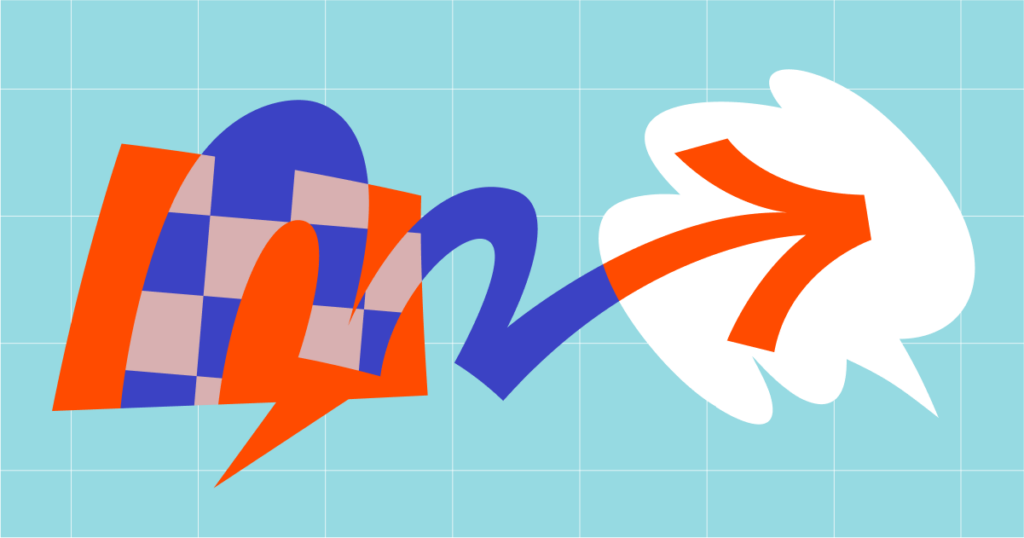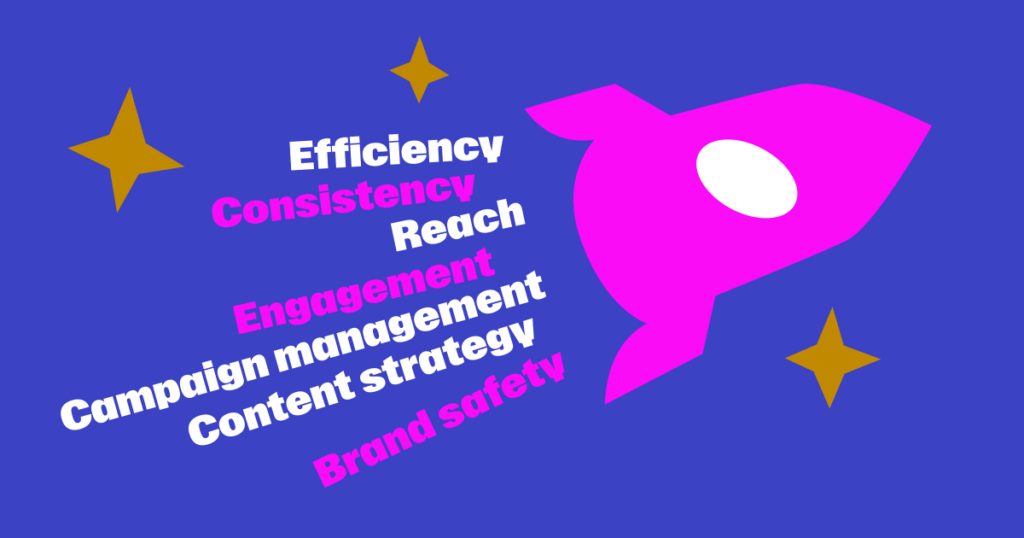It’s been a hot AI summer partly because of the promise the technology holds: automating the more tedious aspects of work, freeing up more time for humans to engage in what’s more meaningful to us. That’s also the promise of Instagram automation as part of a wider digital marketing strategy.
Creators struggle to balance demands on their time, especially if their Instagram presence is part of a side hustle. It’s difficult to keep up with competitors, trends, and a constantly changing algorithm. A drain on your time and resources leaves you feeling tapped out creatively, too.
Success depends on working smarter — like finding the pieces of your digital marketing strategy that can be automated. We’ll explore the evolving landscape, from what’s possible right now to contemplating the future of Instagram automation.
Gaze into our crystal ball to get started.

What Do We Mean When We Say Automation?
A lot of automation is already integrated into our daily lives: smart thermostats, out-of-office replies, self-driving cars that are always five years away from being fully autonomous and solving traffic forever (we can dream).
Automation is a technology (usually third-party tools or software built on available APIs; more on this later) that does tedious, repetitive tasks for us. This tech is getting better and better at it, taking on increasingly sophisticated tasks. Responsible automation helps brands streamline and optimize their digital marketing efforts from email campaigns to a social media presence.
Instagram Automation
That brings us to Instagram automation. Managing and growing a successful Instagram account with a highly engaged audience takes time and energy. Putting some aspects of that on autopilot frees creators up to concentrate on what has the most impact on their business.
You can currently automate the following on Instagram, starting with the content publishing and management most users are familiar with:
- Post scheduling: Tools that handle tasks like scheduling and content queues have been around for so long that most creators might not even think of them as automation anymore; the same goes for the ability to cross-post content to multiple platforms.
- Post engagement: Liking and commenting on posts, responding to comments, and also responding to DMs (which everyone has experienced abuse of in the form of bots; more on this in a moment).
- Follower engagement: Following and unfollowing accounts based on certain criteria, and removing inactive followers (or somewhat ironically, bots).
- Content creation: AI tools make it possible to create or enhance images and videos based on prompts, write captions, and suggest hashtags.
- Research and reporting: Some tools can generate automatic reports around content performance, while others can engage in research around hashtags and competitors (the depth depends on your budget).
- Contest and ad campaign management: Tools can also help run a contest or target ads based on performance data (this is available natively through Instagram ads).
- Influencer outreach: Other tools can help reach out to influencers for partnerships based on specific criteria.
Depending on your goals for your brand’s Instagram presence — and your digital marketing budget — you might automate some or all of these tasks. We caution against an overreliance on automation since generic comment replies or DMs are easy for audiences to flag as “spammy.” Once you have that reputation, it takes a lot of hard, manual work to win your audience back, eating up any time you might have initially saved with all of that automation.
We also want to note that while some of these actions are possible through third-party tools, they can also violate what is officially allowed through Instagram’s APIs. Tools built for automated following and unfollowing, liking and commenting (on posts that aren’t your own), and sending DMs that aren’t approved business use cases violate the rules. They risk being shut down — and taking all of your data with them.
Instagram’s Automation Policies
While you can automate a wide range of activities on Instagram, that doesn’t mean you should — especially if it violates Instagram’s policies, including their Terms of Use and what’s allowed through their APIs. Unauthorized automation (like chatbots pretending to be human) is explicitly prohibited.
Instagram APIs also restrict the automation of certain activities to prevent spam and preserve a better user experience. They don’t allow automation of:
- Following or unfollowing
- Liking or commenting
- Direct messaging (except for approved business use cases)
They also don’t allow scraping of user data beyond what’s explicitly provided by the API in the form of basic profile information, photos, and videos. Any third-party apps or tools built on Instagram’s APIs are also subject to rate limits (the number of requests or actions you can take in a certain period), approvals, and other restrictions. The data available through an API can change at any time.
The APIs do allow:
- Scheduling and publishing posts
- Retrieving analytics and insights
- Managing comments (retrieving, responding, hiding, and deleting)
- Searching public content by hashtag (with limitations)
- Managing business profiles and catalogs
The key is implementing a balance of reputable tools that help automate your brand presence in impactful ways, freeing up your time to do more creative work that robots never quite get right. Manychat’s Instagram Automations are just one option to explore (and we’re an approved Facebook (now Meta) Business Partner so you never have to worry about breaking the rules).

What Instagram Automation Can Do for You and Your Business
Automation done right streamlines your business, and Instagram is the perfect place to start. It helps boost your business by improving:
- Efficiency: Save time by scheduling content in batches and automating repetitive tasks like responding to common questions in DMs with personalized, on-brand answers.
- Consistency: Batching and scheduling content means your audience knows when to expect updates from you, and your brand voice remains consistent across your posts (bonus points for repurposing across platforms!).
- Reach: Cross-posting and using automatically-suggested hashtags help expand your audience in a targeted way.
- Engagement: Customers don’t have to wait as long for a response in your DMs or comments, and mentions get reactions right away, solidifying brand loyalty and increasing the likelihood followers will engage with and share your content again in the future.
- Campaign management: From organic campaigns to ads, automating some aspects helps make the lift lighter, so you can do more.
- Content strategy: From knowing when to post to how your audience is reacting to your content, automating posting and report generation helps tighten workflows.
- Brand safety: Automation helps with content moderation, like automatically filtering out inappropriate comments.
All of this gives you time to spend where it matters most: creative brainstorming of new content and focusing on other aspects of running your brand that impact your bottom line. Automation also helps you scale your business and stay on par with competitors using the same technology.
Just be sure you don’t become too dependent on it — or you risk alienating your audience through a lack of authenticity.

Caution: Potential Risks and Challenges of Instagram Automation
The biggest mistake creators can make with automation is automating too much and losing the crucial human element in their social presence. It’s one thing to appear polished and responsive; it’s another to come across as cold, robotic, or even spammy. Audiences want authenticity.
The most value lies in striking a balance that frees up your time for more strategic, creative work while still driving a real connection in your social presence with your audience. Once you lose the respect of your audience, it’s incredibly difficult to win it back. Your brand reputation takes a big hit, resulting in a loss of business and audience.
Overreliance on automation can also signal that your brand is stretched too thin. That’s a sign to reevaluate your goals and resources, and realign your strategy and approach.

Best Practices: Getting Instagram Automation Right
Choose which tasks you’ll automate and which you’ll still do manually. Start with this checklist of best practices and adjust your strategy based on what makes the most sense for your business at its current stage:
- Use approved automation tools: Be suspicious of any tools that offer services that violate Instagram’s Terms of Use or anything explicitly banned by the Instagram APIs.
- Focus on quality over quantity: Automate the most tedious, repetitive tasks to open up your time for more creative, impactful work.
- Automate the numbers: Analytics, reporting, and more; ad spend is one thing that can make a difference with automation, both in terms of your ad performance and your resources!
- Automate A/B testing: As part of your content strategy, automatically test two different versions of content (paid or organic) to see which performs better and use that to inform your approach going forward.
- Stay updated and comply with regulations: Keep an eye on Instagram’s updates (and on this blog) to make sure you’re working with the latest rules and regulations.
- Implement automation responsibly: Don’t automate everything just because you can; choose wisely and make any messaging as personalized and on-brand as possible.
For example, you might start Instagram automation with DMs around certain questions you’re asked frequently, then switch to human responses when the automated answers can’t cover it anymore.
You can also design highly personalized automated responses to comments or DMs that show your audience that while you’re busy, you still know them well enough to craft a message that resonates with them and reminds them why they’re an engaged fan of your brand.
Be sure you’re tracking the responses to any automation you have in place and using that feedback to adjust your strategy. Sometimes all you need is a little tweak in the language you’re using in your automated responses to get more out of them. Other times it will become clear that something you’ve automated still needs to be handled manually.
As long as you’re responsive to feedback, it shouldn’t snowball into an issue for your brand.

Magic 8 Ball Says: Future Trends around Instagram Automation
While gazing into the future usually returns “reply hazy,” it’s still fun to make educated guesses about what lies ahead in the future of Instagram automation.
AI and Machine Learning Integrations
Creating an artificial intelligence on par with the human brain isn’t likely any time soon (sorry, Skynet fans), but the technology should keep improving as experts optimize training data and modeling that goes into building the large language models (LLMs) that make up the AI systems most of us are familiar with.
With Instagram automation specifically, that could look like improved editing tools for images and video, suggested captions and hashtags, or suggestions for which format to post certain types of content in (Reels vs. Stories, for example). Augmented Reality (AR) fans might see suggestions for AR filters and effects.
More sophisticated advancements could include personalized automated responses in comments and DMs based on behavior and user history (with approved business cases, of course). Matching brands and influencers with more complex criteria is another possibility, along with automated real-time content moderation.
Advanced Analytics and Predictive Modeling
The robots excel at analytics and data modeling. Advancements in AI could mean huge improvements in forecasting trends and topics before they reach their peak, allowing creators to adjust their content strategy in real time with content still tailored to their brand and audience.
Models could also predict ideal posting times and types of content to post based on more sophisticated combinations of audience analysis, seasonality, and past behavior. Sentiment analysis is notoriously tricky for technology since robots tend to miss sarcasm, hyperbole, or other figures of speech. Advancements in natural language processing (NLP) could improve this, letting creators see at a glance how audiences feel about their content.

The Future’s So Bright Instagram Automation’s Gotta Wear Shades
The worst possible future is everyone fully automating every action possible on Instagram so it becomes a wasteland of bots “talking” to each other. Fortunately, that kind of behavior is already banned by the official APIs. As technology advances to circumvent the rules, it will also advance to combat the rule-breakers.
The takeaway from all of this isn’t that automation is bad; it’s that irresponsible automation results in a subpar user experience. Bad user experiences drive away fans, followers, and potential customers, shrinking your audience and limiting your business potential.
Automating smartly streamlines your digital marketing efforts while letting the human element shine — letting your audience connect with your brand authentically.
Want to learn more about Manychat’s Instagram automation capabilities now and in the future? Join us for our Instagram Summit, coming up in October!














